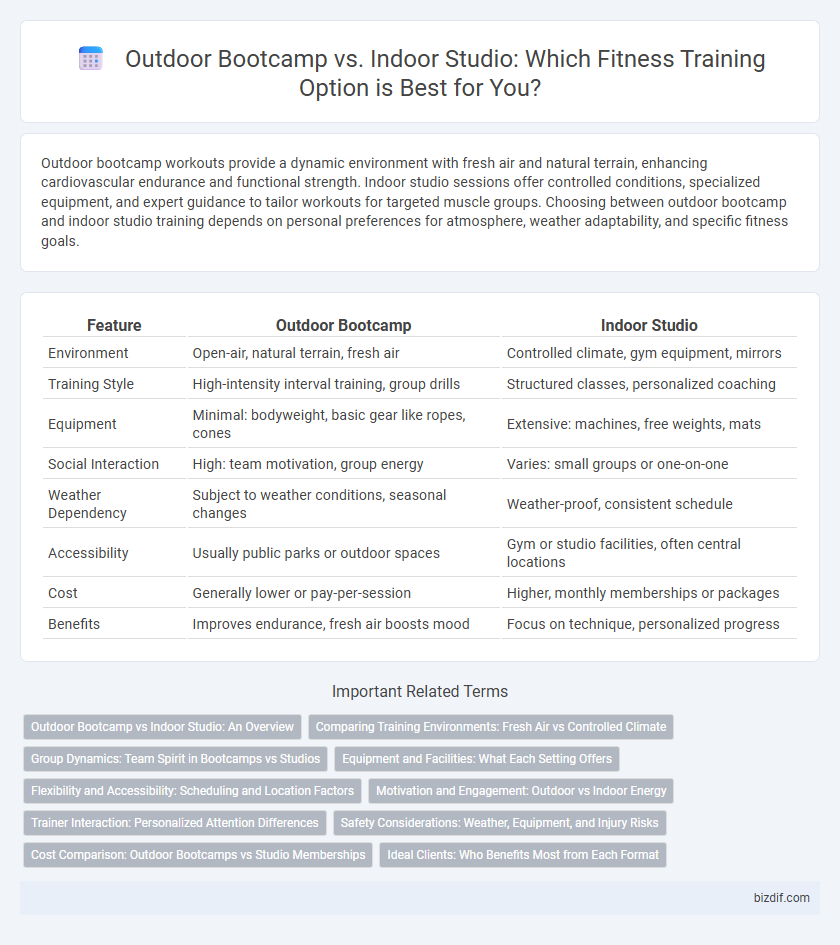Outdoor bootcamp workouts provide a dynamic environment with fresh air and natural terrain, enhancing cardiovascular endurance and functional strength. Indoor studio sessions offer controlled conditions, specialized equipment, and expert guidance to tailor workouts for targeted muscle groups. Choosing between outdoor bootcamp and indoor studio training depends on personal preferences for atmosphere, weather adaptability, and specific fitness goals.
Table of Comparison
| Feature | Outdoor Bootcamp | Indoor Studio |
|---|---|---|
| Environment | Open-air, natural terrain, fresh air | Controlled climate, gym equipment, mirrors |
| Training Style | High-intensity interval training, group drills | Structured classes, personalized coaching |
| Equipment | Minimal: bodyweight, basic gear like ropes, cones | Extensive: machines, free weights, mats |
| Social Interaction | High: team motivation, group energy | Varies: small groups or one-on-one |
| Weather Dependency | Subject to weather conditions, seasonal changes | Weather-proof, consistent schedule |
| Accessibility | Usually public parks or outdoor spaces | Gym or studio facilities, often central locations |
| Cost | Generally lower or pay-per-session | Higher, monthly memberships or packages |
| Benefits | Improves endurance, fresh air boosts mood | Focus on technique, personalized progress |
Outdoor Bootcamp vs Indoor Studio: An Overview
Outdoor bootcamp workouts offer diverse terrain and natural elements that enhance cardiovascular endurance and functional strength more dynamically than indoor studios. Indoor studio sessions provide controlled environments with advanced equipment and climate control, promoting focused strength training and technique refinement. Choosing between outdoor bootcamp and indoor studio depends on fitness goals, environmental preferences, and desired social interaction levels.
Comparing Training Environments: Fresh Air vs Controlled Climate
Outdoor bootcamp training offers the advantage of fresh air, natural sunlight, and varied terrain, which can enhance cardiovascular performance and mental well-being. Indoor studio sessions provide a controlled climate with consistent temperature and humidity, minimizing weather-related disruptions and allowing for year-round training. Both environments impact workout intensity and recovery, making the choice dependent on personal preference and specific fitness goals.
Group Dynamics: Team Spirit in Bootcamps vs Studios
Outdoor bootcamps foster heightened team spirit through shared challenges in a dynamic, open environment, promoting camaraderie and collective motivation. Indoor studios, while controlled and focused, may limit spontaneous interaction but offer structured group exercises that build consistent support networks. Group dynamics in bootcamps emphasize resilience and adaptability, contrasting with the precise coordination and technique refinement seen in studio sessions.
Equipment and Facilities: What Each Setting Offers
Outdoor bootcamps typically utilize natural terrain and portable equipment such as resistance bands, kettlebells, and agility ladders, offering a varied and dynamic workout environment. Indoor studios provide access to advanced machinery like treadmills, stationary bikes, weight racks, and controlled climate settings, optimizing performance and comfort. Both settings enhance fitness training by catering to different preferences in equipment availability and facility infrastructure.
Flexibility and Accessibility: Scheduling and Location Factors
Outdoor bootcamp classes offer greater flexibility with varied schedules and multiple locations, accommodating participants' preferences for morning or evening workouts in different environments. Indoor studio sessions provide consistent, climate-controlled settings and fixed schedules, benefiting those who prefer structured routines regardless of weather conditions. Accessibility depends on individual proximity to outdoor parks or indoor gyms, with outdoor bootcamps often appealing to community-oriented participants and indoor studios attracting those seeking privacy and specialized equipment.
Motivation and Engagement: Outdoor vs Indoor Energy
Outdoor bootcamp workouts harness natural elements and fresh air to boost motivation by creating a dynamic and invigorating environment that stimulates both body and mind. Indoor studio sessions offer controlled climate and specialized equipment, fostering focus and sustained engagement through structured routines and interactive coaching. The choice between outdoor and indoor fitness environments significantly impacts energy levels, with outdoor settings promoting varied sensory experiences and indoor studios providing consistency and targeted support for goal achievement.
Trainer Interaction: Personalized Attention Differences
Outdoor bootcamps often offer dynamic trainer interaction with group-based encouragement, fostering motivation in a social environment, while indoor studios provide more personalized attention through one-on-one coaching and tailored feedback. Trainers in indoor settings can closely monitor form and adjust workouts in real-time, enhancing exercise precision and reducing injury risk. Group outdoor sessions may limit individualized corrections but increase camaraderie and collective energy.
Safety Considerations: Weather, Equipment, and Injury Risks
Outdoor bootcamp training exposes participants to variable weather conditions, increasing risks of heat exhaustion or hypothermia, while indoor studios offer climate-controlled environments that enhance safety. Equipment maintenance and surface stability are more unpredictable outdoors, potentially leading to higher injury risks, whereas indoor studios provide standardized, well-maintained gear and flooring designed to minimize impact. Trainers in both settings must prioritize proper warm-ups, hydration, and technique to reduce injury likelihood, but controlled indoor environments generally offer enhanced safety measures for consistent workouts.
Cost Comparison: Outdoor Bootcamps vs Studio Memberships
Outdoor bootcamp classes typically offer more affordable rates, often ranging from $10 to $30 per session, compared to indoor studio memberships that can average $100 to $200 monthly. Bootcamps eliminate facility overhead costs, passing savings on to participants, while studios incur expenses for equipment, space rental, and amenities. Cost efficiency in outdoor bootcamps makes them a budget-friendly option for high-intensity fitness training without compromising workout quality.
Ideal Clients: Who Benefits Most from Each Format
Outdoor bootcamp training suits individuals seeking dynamic, high-energy workouts in fresh air, often favoring those who thrive on varied terrain and natural surroundings for motivation. Indoor studio sessions benefit clients preferring controlled environments, precise equipment, and climate-controlled settings, such as individuals focused on consistent form, rehabilitation, or specialized group classes. Both formats cater to different fitness goals and preferences, with outdoor bootcamps ideal for social, adventurous participants and indoor studios optimal for those valuing structure and comfort.
Outdoor Bootcamp vs Indoor Studio Infographic

 bizdif.com
bizdif.com